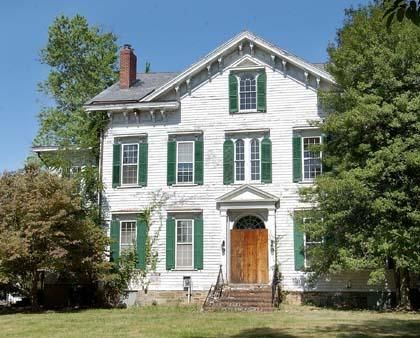By Lea Kahn, Staff Writer
LAWRENCE — CareOne Management LLC wants to develop an assisted living facility on the corner of Route 206 and Province Line Road, but the only thing standing in its way is the historic — and slowly deteriorating — William Gulick House.
The company, which operates nursing homes and assisted living facilities statewide, continued to make its case for demolition of the 19th-century farmhouse in front of the Zoning Board of Adjustment Wednesday night. It is appealing Construction Official Anthony Cermele’s denial of an application for a demolition permit.
Mr. Cermele based his decision on the township Historic Preservation Advisory Committee’s denial of the company’s request to tear down the house in November 2015.
This week, company representatives argued that the house, which was built in 1855 for wealthy farmer William Gulick, is in poor condition and would cost too much to repair. They also argued that while the house was incorporated into an earlier plan for an assisted living facility, state regulations would not allow it now.
CareOne’s in-house architect, Angelo Caputo, said he had searched the company’s records and could find very little about the house’s maintenance since a predecessor company — Lawrenceville Realty LLC — acquired the property in 1996.
Between 2011 and 2015, CareOne Management LLC paid $25,000 for landscaping maintenance, but there are no records of other repairs, Mr. Caputo said. The house has been boarded up and surrounded by a chain link fence to keep out intruders.
Launching into the reasons for demolishing the William Gulick House, Mr. Caputo outlined the nearly 20-year-long history of the company’s application for a use variance for an assisted living facility. The variance was needed because assisted living facilities are not permitted uses in a residential zone.
The Zoning Board of Adjustment denied the initial use variance application in 1997, and the company fought its way through the courts to overturn it. The zoning board approved a use variance application in 1999 for an assisted living facility that included the house in the plans, but the project did not go forward.
A third use variance application was filed in 2005 by CareOne Management LLC, which called for demolishing the house. But because the applicant did not follow through and appear at public hearings on it, the zoning board denied the application “without prejudice” in 2011 — meaning it could submit another use variance application.
Mr. Caputo speculated that the applicant never followed through because the proposed assisted living facility addition to the William Gulick House was too small and poorly designed. He also said that the market had changed, and that it would be necessary to reanalyze the situation before spending millions of dollars on the project.
When planning consultant Brian Slaugh asked Mr. Caputo why CareOne is still holding onto the property even after it decided that the application did not match the current business model, Mr. Caputo replied that “it’s a tough question to answer.” He added that CareOne still believes there is a need for an assisted living facility in Lawrence, which he described as a “great town.”
Zoning Board of Adjustment Chairman Sam Pangaldi and Mr. Slaugh challenged Mr. Caputo on the lack of maintenance of the house since the 2005 use variance application was denied in 2011. The intent was to preserve the house and keep it well maintained, Mr. Pangaldi said.
“All of a sudden, it is not a good fit and you let it to go to crap,” Mr. Pangaldi said. It is an historic house and it is important to Lawrence residents, he said, while zoning board member Joseph Blaney added that CareOne could have done a better job in maintaining it. The house is an “eyesore,” Mr. Blaney said.
Mr. Caputo defended the company’s plan to build an assisted living facility on the property, adding that it would be advantageous for Lawrence. Sooner or later, the property will be developed and “we want to be part of this beautiful town,” he said.
Mr. Caputo also defended CareOne’s goal to demolish the William Gulick House, because it cannot be incorporated into an assisted living facility. State regulations will not allow the wood-frame house to become attached to a wood-frame-constructed assisted living facility, he said.
Then maybe CareOne should “cut loose” from the project if the historic house cannot be part of it, said Ed McDonald, the chairman of the township’s Historic Preservation Advisory Committee. The township will suffer the loss of the house, he said.
But Mr. Caputo said the company is going to fight until it can prove its case. A decision may be reached at the Zoning Board of Adjustment’s Aug. 17 meeting.

